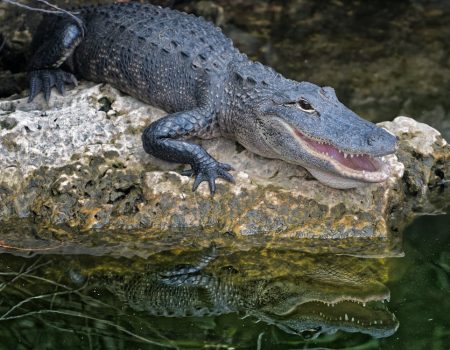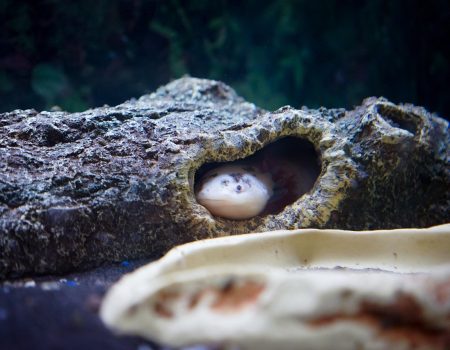You’ve set up a cozy tank for your axolotl, and everything seems perfect. But suddenly, your water tests reveal an ammonia spike, and your little friend might be at risk.
If this sounds familiar, you’re not alone. Keeping ammonia levels in check is one of the biggest challenges for axolotl owners, but it doesn’t have to be overwhelming.
With the right steps, you can create a safe, stable environment that keeps your axolotl happy and healthy.
Why Ammonia Spikes Happen in Axolotl Tanks

Ammonia spikes usually occur because of waste buildup. Axolotls produce a lot of waste, and if your tank’s filtration or maintenance routine isn’t up to par, ammonia levels can rise quickly. Uneaten food, decaying plants, and poor water changes are common culprits.
The recommended KH level for axolotl tanks is between 3 to 8 dKH (53 to 143 ppm), which helps stabilize pH and supports beneficial bacteria.
- Overfeeding leads to excess waste and leftover food breaking down.
- Inadequate filtration can’t process ammonia efficiently.
- Skipping water changes allows waste to accumulate.
Understanding these triggers makes it easier to prevent problems before they start.
Set Up a Strong Filtration System
A reliable filter is your first line of defense against ammonia. Axolotls are messy eaters, and without proper filtration, their waste can overwhelm your tank. Look for a filter that’s efficient but gentle enough for axolotls, as they prefer calm water.
Choose the Right Filter
- Sponge filters: These are great for small tanks and provide both mechanical and biological filtration.
- Canister filters: Ideal for larger tanks, they handle higher loads of waste.
Make sure your filter is cycled before introducing your axolotl. Cycling allows beneficial bacteria to establish, which helps break down ammonia into less harmful substances like nitrite and nitrate.
The ideal pH for axolotls is between 7.4 and 7.6, with values below 7 being potentially harmful if not monitored closely.
Regular Filter Maintenance
Even the best filter won’t work if it’s clogged. Clean it monthly to remove debris but don’t over-clean, as this can disrupt the beneficial bacteria. Use tank water to rinse filter media to avoid killing the bacteria.
Monitor Water Quality Regularly
You can’t manage what you don’t measure. Testing your water often helps you catch ammonia spikes early, so you can act before they harm your axolotl.
Test Kits to Use
Invest in a liquid test kit for accurate readings of ammonia, nitrite, and nitrate levels. Strips are convenient but less reliable. Aim to test your tank:
- Weekly during regular maintenance.
- Daily if you’re cycling a new tank or suspect a spike.
What Levels Are Safe?
- Ammonia: Should always be 0 ppm.
- Nitrite: Keep this at 0 ppm too.
- Nitrate: Under 20 ppm is ideal.
If ammonia levels rise, take immediate steps like a partial water change or adding a detoxifier.
Axolotls can tolerate nitrate levels up to 40 ppm, but the ideal range is between 5 to 20 ppm for optimal health.
Perform Consistent Water Changes
Regular water changes are the backbone of a healthy axolotl tank. They remove waste, lower ammonia, and refresh the water. Neglecting this step is one of the quickest ways to see ammonia spikes.
How Often Should You Change the Water?
- 20-30% weekly is the general rule for stable tanks.
- If ammonia levels are high, you may need to do 50% changes daily until it’s back to 0 ppm.
Always treat tap water with a dechlorinator to protect your axolotl from chlorine and chloramine.
Use a Gravel Vacuum
During water changes, use a gravel vacuum to clean the substrate. Axolotls are messy, and uneaten food or waste can get trapped in the substrate, leading to ammonia buildup. A quick vacuuming during each water change can make a big difference.
Avoid Overfeeding Your Axolotl
It’s tempting to spoil your axolotl, but overfeeding is one of the leading causes of ammonia spikes. Excess food decomposes quickly, releasing ammonia into the water.
Feeding Tips
- Feed your axolotl once every 2-3 days.
- Remove uneaten food after 10-15 minutes to prevent decay.
- Offer portion sizes appropriate to their size—usually a piece of food about as big as their head.
Sticking to a proper feeding routine not only keeps ammonia levels stable but also promotes better health for your axolotl.
Add Live Plants for Natural Filtration
Live plants do more than just look good; they also help absorb ammonia and nitrates, acting as a natural filtration system.
Best Plants for Axolotl Tanks
- Anubias: Low-light and hardy, perfect for tanks with axolotls.
- Java Fern: Another robust option that thrives in similar conditions.
- Hornwort: Excellent for absorbing nutrients like ammonia and nitrates.
Plants not only improve water quality but also provide shade and hiding spots for your axolotl.
Keep Plants Healthy
Dead or decaying plant matter can contribute to ammonia spikes, so trim dying leaves regularly and remove any debris.
Establish a Stable Tank Cycle
The nitrogen cycle is the backbone of a healthy aquarium. Without it, ammonia can quickly reach toxic levels. Cycling your tank before adding an axolotl is crucial to establishing beneficial bacteria that break down waste.
How to Cycle a Tank
- Add a source of ammonia, like fish food or pure ammonia.
- Monitor ammonia, nitrite, and nitrate levels using a test kit.
- Wait until ammonia and nitrite are 0 ppm and nitrates are under 20 ppm.
This process can take 4-6 weeks, so be patient. If you already have an axolotl in the tank, use products like bacteria starters to help speed up the process.
Signs of a Disrupted Cycle
- Sudden ammonia spikes after cleaning the filter or adding new fish.
- Cloudy water (bacterial bloom).
If the cycle gets disrupted, test your water frequently and take corrective action like adding bacteria supplements.
Use Ammonia Neutralizers When Needed
Sometimes, despite your best efforts, ammonia levels can spike. When that happens, ammonia neutralizers can offer a quick fix. These products don’t replace regular maintenance but can give you extra time to address the root cause.
When to Use Neutralizers
- During emergencies when ammonia levels are high.
- While cycling a new tank with an axolotl present.
Products like Seachem Prime are popular because they detoxify ammonia while keeping it available for beneficial bacteria to process.
Don’t Rely on Them Alone
Neutralizers are a tool, not a solution. Combine them with water changes and improved tank practices to ensure long-term stability.
Keep the Tank Size Appropriate
Axolotls need space, and overcrowding can lead to rapid ammonia spikes. Their waste production increases with stress and competition, so a roomy tank is essential.
Minimum Tank Size
- 20 gallons for one axolotl is the minimum recommendation.
- Add an extra 10 gallons for each additional axolotl.
A larger tank also dilutes waste better, reducing the risk of ammonia problems.
Avoid Overcrowding
Keep only compatible tankmates with your axolotl, if any. Axolotls prefer solitude, and additional fish or other creatures often produce waste that can overwhelm your filtration system.
Clean Substrate and Decorations
Your tank’s substrate and decorations can trap waste and debris, contributing to ammonia buildup. Regular cleaning helps maintain a healthy environment.
Best Practices for Substrate
- Use fine sand or bare-bottom tanks to make cleaning easier.
- Avoid gravel, as axolotls might accidentally ingest it.
During water changes, clean the substrate thoroughly with a siphon or gravel vacuum.
Cleaning Decorations
Remove and scrub decorations monthly with warm water. Avoid using soap or harsh chemicals, as they can harm your axolotl. This prevents algae and waste buildup, keeping your tank clean and ammonia-free.
Quarantine New Additions
Adding new fish, plants, or decorations without quarantine can introduce harmful bacteria or excess organic matter, leading to ammonia spikes.
Quarantine Guidelines
- Isolate new fish or plants in a separate tank for at least 2 weeks.
- Inspect plants for dead or decaying material before adding them.
This simple step helps protect your established tank from unexpected issues.
Act Fast During an Ammonia Spike
If you notice an ammonia spike, take immediate action to protect your axolotl.
Emergency Steps
- Perform a 50% water change to lower ammonia levels.
- Add an ammonia neutralizer like Seachem Prime.
- Test water daily and continue partial water changes until levels stabilize.
Acting quickly minimizes stress and health risks for your axolotl.
Wrapping It Up: A Happy, Stable Tank
Preventing ammonia spikes is all about consistency. Stick to a routine of water changes, feeding, and monitoring, and your axolotl will thrive in a clean, safe environment.
A little effort goes a long way, and your axolotl will reward you with years of fascinating companionship. Keep testing, maintain good filtration, and enjoy the experience of caring for your unique aquatic pet.
References
Ammonia Management in Aquariums – LiveAquaria
Ammonia Spike: How to Get It Down – Caudata.org
Please help! Low pH and high ammonia – Reddit
How do I lower nitrite and nitrate levels in my axolotl tank fast? – Quora
Veterinary Information Network – VIN
Disclaimer
This content on Bagrica is for informational purposes only. Consult a professional for pet care or farming advice. Bagrica is not liable for any actions taken based on this information.







No Comment! Be the first one.